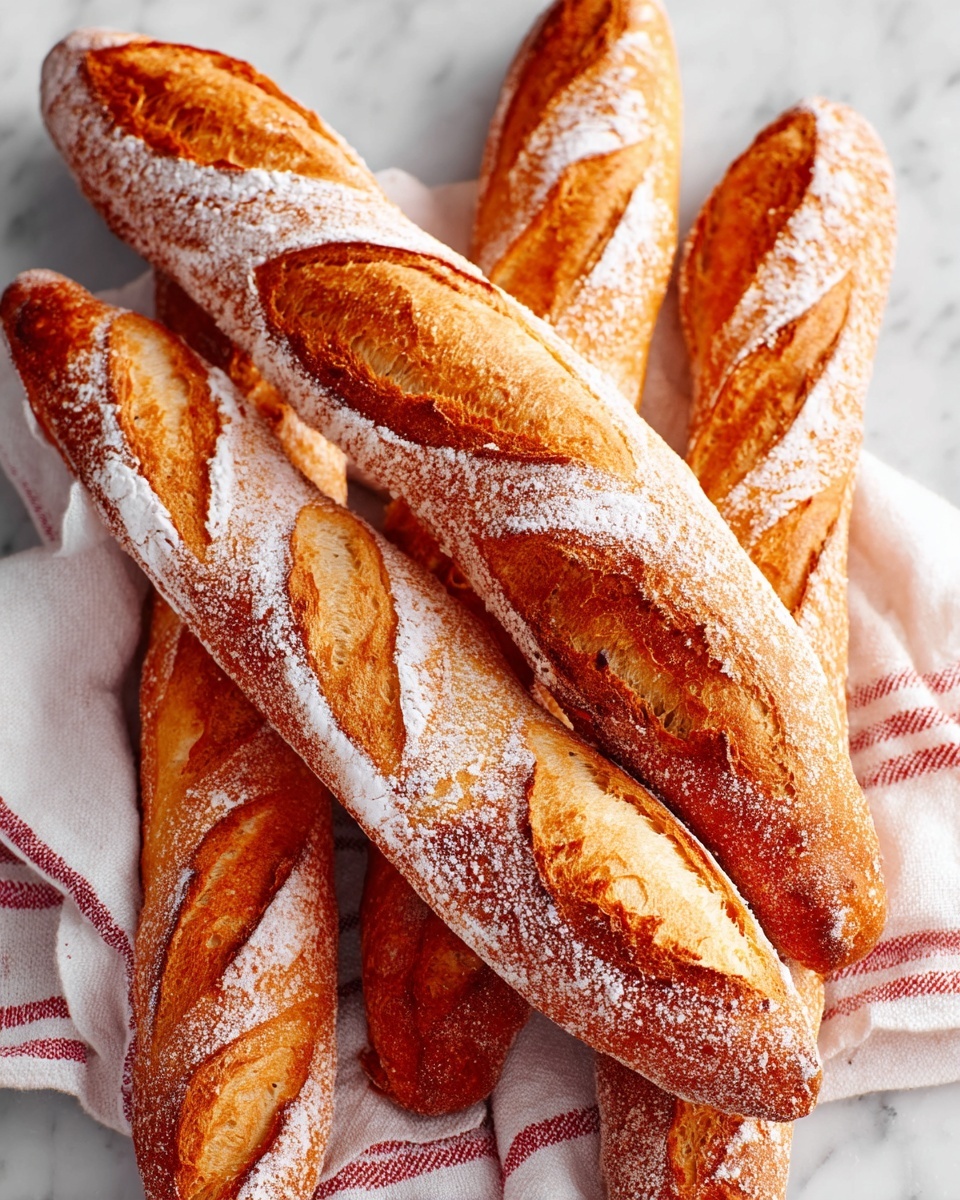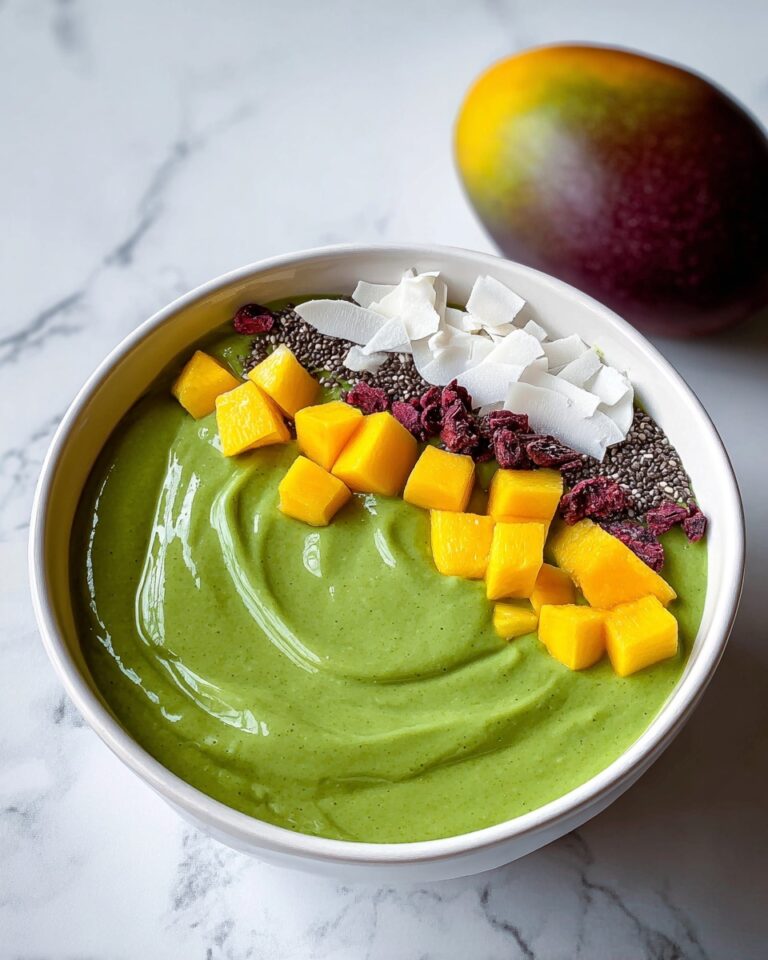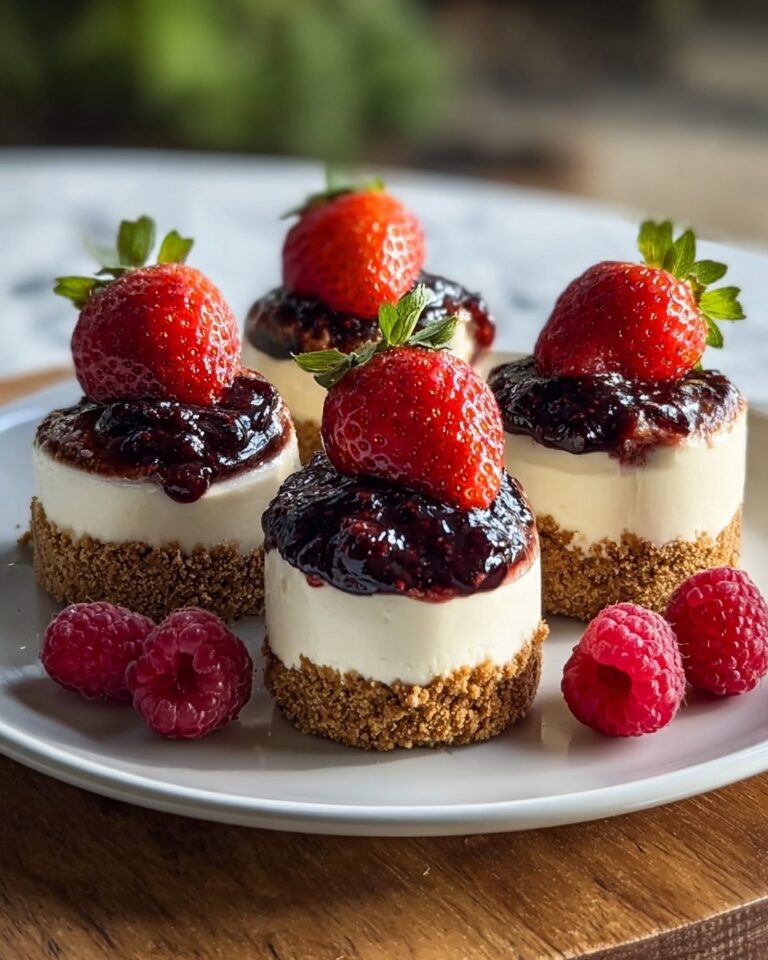If you’ve ever dreamed of replicating that irresistible, crunchy exterior paired with a soft, airy crumb right in your own kitchen, then this Classic Crusty French Baguettes Recipe is exactly what you need. The beauty of this recipe lies in its simplicity and authenticity—just a handful of basic ingredients coming together to create that iconic French staple that’s perfect for sandwiches, cheese boards, or simply smeared with butter and jam. Whether you’re a novice baker or a bread aficionado, these baguettes will raise the bar for homemade artisan bread and fill your home with a heavenly aroma.
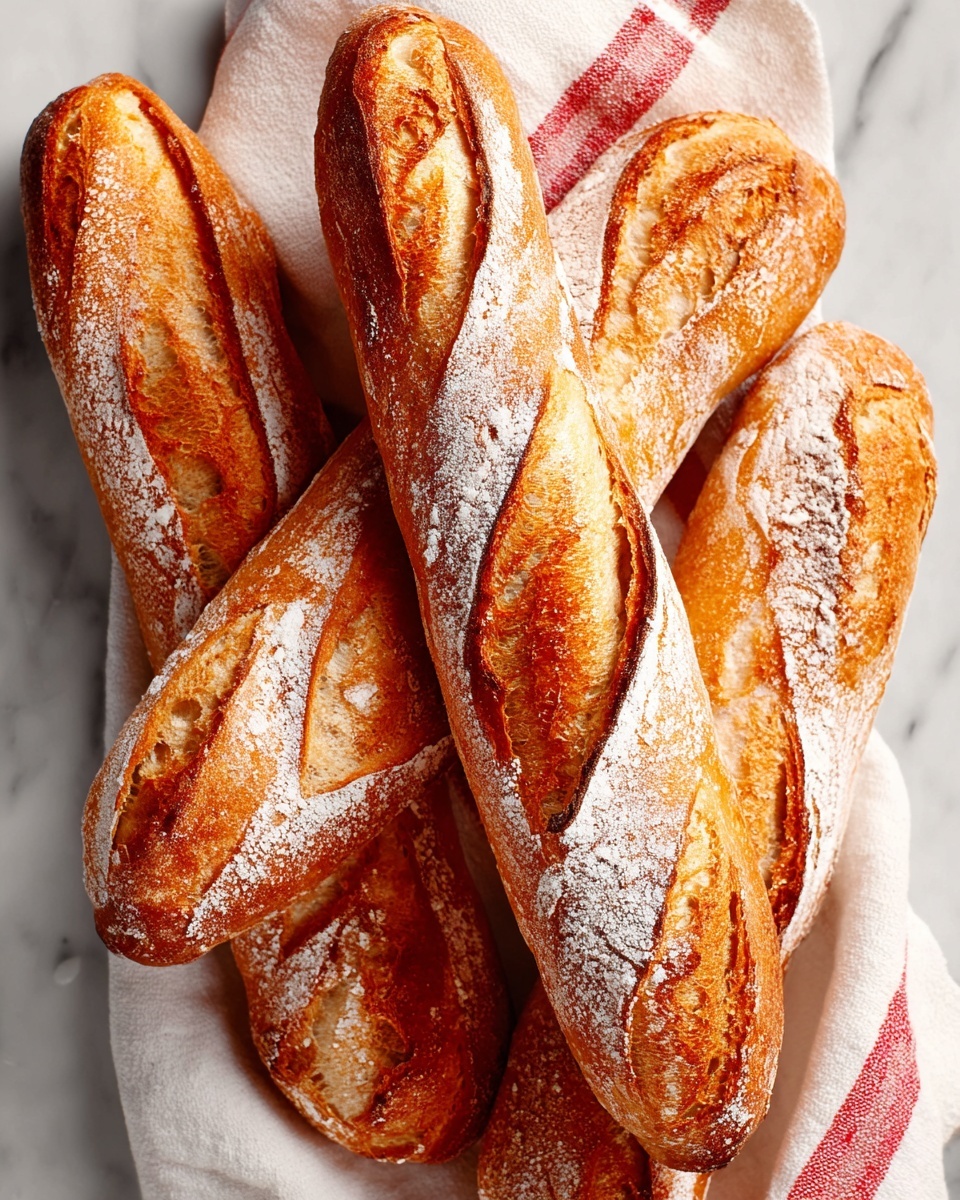
Ingredients You’ll Need
Sometimes the simplest ingredients make the best bread. Each element in this Classic Crusty French Baguettes Recipe plays a crucial role in achieving the perfect taste, texture, and appearance that baguettes are famous for.
- Bread Flour (4 cups): Provides the strong gluten structure essential for that chewy interior and impressive rise.
- Salt (1 1/2 teaspoons): Enhances flavor and controls yeast fermentation, ensuring a balanced taste.
- Active Dry Yeast (1 packet or 2 1/4 teaspoons): The magic agent that helps the dough rise to fluffy perfection.
- Warm Water (1 1/2 cups at 110°F): Activates the yeast and helps create the dough’s texture.
- Sugar (1 teaspoon): Just enough to feed the yeast and support that golden crust’s development.
How to Make Classic Crusty French Baguettes Recipe
Step 1: Activate the Yeast
Start by combining warm water, sugar, and yeast in a small bowl. Stir gently and let it sit for about 5 to 10 minutes until it becomes foamy and bubbly. This step ensures your yeast is alive and kicking, which is essential for the dough to rise beautifully.
Step 2: Mix the Dough
In a large mixing bowl, whisk together the bread flour and salt. Gradually pour the yeast mixture into the bowl, stirring as you go. You’ll want to mix until a shaggy dough forms—don’t worry if it looks messy at first; that’s the start of something wonderful.
Step 3: Knead for Texture
Turn the dough out onto a lightly floured surface and knead it vigorously for 8 to 10 minutes. This kneading develops gluten strands, resulting in a dough that’s smooth, elastic, and perfect for trapping those lovely air pockets inside the baguette.
Step 4: First Rise
Place your dough in a greased bowl, cover it with a clean towel or plastic wrap, and set it in a warm spot. Let it rise until it has doubled in size—this typically takes about an hour. This gentle rising is what brings life to the dough, making it light and airy.
Step 5: Shape the Baguettes
Punch down the dough to release excess gas, then divide it into two or three equal pieces. Take each piece, flatten it into a rectangle, fold it lengthwise, and roll it into that signature long, skinny loaf shape. Don’t forget to gently taper the ends for that authentic look!
Step 6: Second Rise
Lay your shaped baguettes on a parchment-lined baking sheet or a baguette pan. Cover loosely with a towel and allow them to rise again for 30 to 40 minutes. This final rise gives the dough a final puff-up that’s critical for a light, tender crumb.
Step 7: Prepare for Baking
Preheat your oven to 450°F (230°C). Just before baking, score the tops of your baguettes with a sharp knife—this helps control how the bread expands and adds the classic slashed appearance. For extra crusty goodness, place a pan of hot water on the bottom rack to create steam during baking.
Step 8: Bake to Perfection
Slide the baguettes into the oven’s middle rack and bake for 20 to 25 minutes. When they turn a rich golden brown with a crackly crust, your efforts have paid off. Be sure to cool them on a wire rack so the crust stays crisp and deliciously crunchy.
How to Serve Classic Crusty French Baguettes Recipe
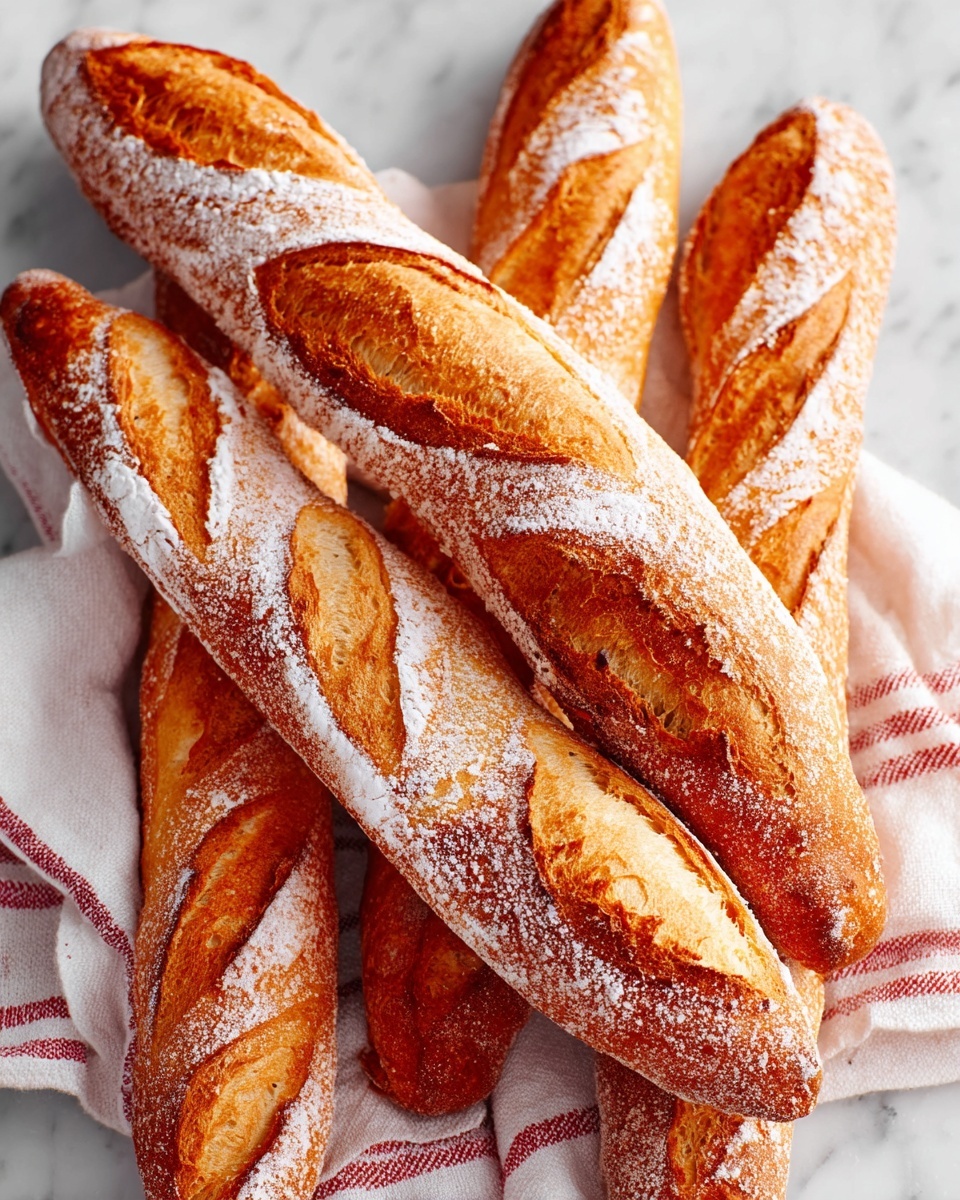
Garnishes
Baguettes are so versatile that a simple spread of creamy butter or a drizzle of good olive oil can elevate the experience instantly. Fresh herbs like thyme or rosemary, or even a sprinkle of flaky sea salt, make divine garnishes that enhance each bite.
Side Dishes
This Classic Crusty French Baguettes Recipe creates bread that pairs beautifully with hearty stews, delicate cheese platters, or vibrant salads. Consider serving alongside classic French onion soup, rich pâté, or your favorite charcuterie for a memorable meal.
Creative Ways to Present
Cut the baguettes into diagonal slices for charming crostini topped with tomatoes and basil, or hollow out sections to make edible bread bowls for dips. Toasting slices to accompany breakfast spreads or layering with fresh ingredients in sandwiches brings plenty of options to your table.
Make Ahead and Storage
Storing Leftovers
If you have leftovers—and that’s rare!—store your baguettes wrapped loosely in a paper bag or a clean kitchen towel at room temperature. This helps maintain the crust’s texture while keeping the crumb soft for a day or two.
Freezing
For longer storage, wrap your baguettes tightly in plastic wrap followed by aluminum foil and place them in the freezer. When you’re ready, thaw at room temperature before reheating to revive that fresh-baked magic.
Reheating
To bring back the glorious crust and warmth, pop the baguettes into a preheated 350°F oven for 5 to 10 minutes. A quick spritz of water on the crust before reheating can revive its crunchiness as if it were just pulled from the oven.
FAQs
Can I use all-purpose flour instead of bread flour?
Absolutely! While bread flour gives the best structure and chewiness due to higher protein content, all-purpose flour will still produce tasty baguettes, just with a slightly softer texture.
Do I need a baguette pan to shape the bread?
Not at all. A parchment-lined baking sheet works perfectly fine. The baguette pan just helps maintain the shape and ensures even baking, but homemade shaping skills can shine on a flat sheet as well.
Why do I need to score the baguettes?
Scoring allows steam to escape, helping the bread expand in a controlled way during baking, plus it gives the distinctive look you expect from a French baguette.
Can I make this recipe with active dry yeast straight from the packet?
Yes! Just be sure to activate the yeast in warm water with sugar first, as this recipe directs, to ensure it’s alive and ready to work its magic.
How long does the baking process take, including rising?
The total time clocks in around two hours—about one hour for the first rise, 30 to 40 minutes for shaping and second rise, plus 20 to 25 minutes of baking. It’s a wonderful leisurely process that rewards patience handsomely.
Final Thoughts
Baking your own Classic Crusty French Baguettes Recipe is an incredibly rewarding experience that fills your home with irresistible aromas and brings a little piece of French bakery magic to your table. I encourage you to roll up your sleeves and give this recipe a try—you’ll be amazed at how simple ingredients and a bit of love can create something so authentically delicious. Happy baking and bon appétit!
Print
Classic Crusty French Baguettes Recipe
- Prep Time: 20 minutes
- Cook Time: 25 minutes
- Total Time: 2 hours (including rising time)
- Yield: 2–3 baguettes
- Category: Bread
- Method: Baking
- Cuisine: French
- Diet: Vegan
Description
Learn how to make classic crusty French baguettes at home with a simple list of ingredients and straightforward baking techniques. This recipe yields golden, crusty loaves with a tender crumb, perfect for sandwiches or enjoying with butter.
Ingredients
For the Dough
- 4 cups bread flour
- 1 1/2 teaspoons salt
- 1 packet (2 1/4 teaspoons) active dry yeast
- 1 1/2 cups warm water (110°F)
- 1 teaspoon sugar
Instructions
- Activate Yeast: In a small bowl, combine warm water, sugar, and yeast. Stir and let sit for 5–10 minutes until foamy, indicating the yeast is active and ready to use.
- Mix Dry Ingredients: In a large mixing bowl, combine the bread flour and salt thoroughly.
- Form Dough: Gradually add the yeast mixture into the flour mixture, stirring until a shaggy dough forms.
- Knead Dough: Transfer the dough to a lightly floured surface and knead for 8–10 minutes until smooth and elastic, developing gluten for structure.
- First Rise: Place the dough in a greased bowl, cover with a cloth or plastic wrap, and let it rise in a warm spot for 1 hour or until doubled in size.
- Divide and Shape: Punch down the risen dough and divide it into 2–3 equal pieces. Flatten each piece into a rectangle, fold lengthwise, and roll to form classic long baguette shapes.
- Second Rise: Arrange the shaped loaves on a parchment-lined baking sheet or baguette pan. Cover loosely and let rise for 30–40 minutes until puffed.
- Prepare Oven and Steam: Preheat the oven to 450°F (230°C). Score the tops of the baguettes with a sharp knife to allow expansion. Place a pan of hot water on the lower oven rack to create steam, essential for a crisp crust.
- Bake: Bake the baguettes on the middle rack for 20–25 minutes until the crust is golden brown and crusty.
- Cool: Remove the baguettes from the oven and cool on a wire rack before slicing to preserve the texture.
Notes
- For extra crispiness, mist the loaves with water just before baking.
- Bread flour provides the best structure, but all-purpose flour can also be used if necessary.
- These baguettes are best enjoyed the day they’re baked; reheat leftovers in the oven to restore their crust.

